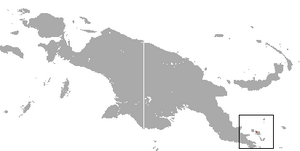Tate's triok facts for kids
Quick facts for kids Tate's triok |
|
|---|---|
| Conservation status | |
| Scientific classification | |
| Genus: |
Dactylopsila
|
| Species: |
tatei
|
 |
|
| Tate's triok range | |
Tate's triok, also known as the Fergusson Island striped possum (Dactylopsila tatei), is a special kind of marsupial. Marsupials are animals like kangaroos or koalas that carry their babies in a pouch. This possum belongs to the Petauridae family. It lives only in Papua New Guinea, which means it is endemic there. You can find it in warm, dry forests.
Contents
Life in the Trees
Tate's triok loves living in trees. It is very rare to see them on the ground. During the day, these possums sleep in nests made of dry leaves. They build these nests inside hollow parts of trees.
Nighttime Habits
Tate's triok is a nocturnal animal. This means it is active only at night. When the sun goes down, it comes out to search for food. Its main diet is insects, so it is an insectivore. But sometimes, it will also chew on tree bark. It might even eat fruits and leaves.
What Tate's Triok Looks Like
Tate's triok is a fairly small animal. It can be about 12 to 31 inches long. That's roughly the length of a ruler or a bit more. It usually weighs between 3 and 25 ounces. That's about as much as a small bag of chips.
Distinctive Stripes
This possum has black fur. It also has two white stripes running down its back. These stripes make it look a bit like a skunk. Its tail is short, and the very tip of it is white.
Amazing Features of Tate's Triok
Tate's triok has some cool body parts. These features help it live its life in the forest.
Special Finger for Food
One special feature is its long fourth finger. This finger is super useful for finding food. The possum uses it to dig out insect larvae. These larvae are often hidden deep inside wood. The long finger also helps it hold onto branches. This keeps its other paw free to grab bigger insects.
How It Finds Hidden Insects
To find the larvae, the striped possum taps on the wood. It uses a special part on its wrist to do this. Then, it listens very carefully. It listens for hollow spots inside the tree. This tells it where the insects might be hiding.
Smelly Defense
Tate's triok also has special glands. These glands can release chemicals from its body. These chemicals create a very strong and unpleasant smell. This bad odor helps to scare away predators. It's a great way to stay safe!
Discovery of Tate's Triok
The first time a Tate's triok was found was in 1935. A person named Fred Shaw Mayer discovered it. After this first discovery, no one could find the animal for a long time. From 1950 to 1980, no expeditions found it. This made many people think the species had gone extinct.
Rediscovery
But in 1992, another Tate's triok was found. It was sleeping inside a tree. Sadly, to get the animal, the hunter cut down the tree. This caused the animal to die.
Behavior of Tate's Triok
Tate's triok are not social animals. They do not live in groups. Instead, they prefer to live alone in their trees.
Protecting Their Space
They can be very territorial. This means they like to protect their own space from other possums. Tate's triok will use their strong, unpleasant smell. This smell warns other striped possums to stay out of their area.
Reproduction and Life Cycle
Like other marsupials, Tate's triok babies are born very tiny. They are not fully developed when they are born. This is because their mothers do not have a very developed placenta.
Growing in the Pouch
To survive, the tiny babies must keep growing. They do this inside their mother's pouch. They stay there for a certain amount of time after birth. Each mother Tate's triok has only two teats. This means she can only feed two babies at a time. This ensures that both babies get enough food to grow strong and healthy.
Why Tate's Triok Is Endangered
There are several reasons why there are not many Tate's triok left.
Small Home Range
First, this animal does not have a very large habitat. Studies have shown that it lives only in a small area. This area is in West Fergusson.
Threat from Logging
This small area of land is often used for logging. Businesses and hunters cut down trees there. When trees are cut down, the Tate's triok loses its home. This loss of suitable habitats may be causing the population number to get smaller.
Images for kids



